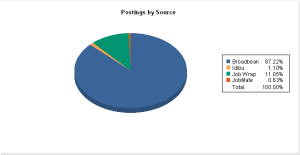So what is a career center network?
Essentially it is a large pool of candidates and job adverts ‘owned’ by a third party vendor which can be plugged into society website with a ‘career center’ interface. As the members of that society start applying for jobs via this system, their details become the property of the external vendor and can then be used to provide other ‘network affiliated sites’ (and in some cases a central network job board) with applications to adverts. As the network grows so does the pool of candidates and reach into the employer market.
These networks generally take a cut of 30-50% of all revenue generated from advertisers and the remainder goes back to the society.
On the surface you can see why this solution has its appeal.
Many of these career center network providers entered the market place in the very late nineties/ early noughties when most organizations were still trying to make sense of how to move their traditional business models online. Print advertising was declining rapidly and advertisers were moving to online solutions. With no expertise or experience in this area, small online audiences and no database of candidates many societies and associations were unable to provide a credible online solution. Those that failed were ultimately unable to satisfy the return their advertisers expected and faced exorbitant costs from career center developers (only to find them obsolete in the space of a few years).
In this context, career center network providers promised off the shelf technology, nominal set up costs, a database of relevant candidates and access to thousands of potential employers. It is easy to understand why so many people said ‘Yes please!’. In this scenario the revenue share agreement was more than offset by the cost savings that societies would have incurred going it alone.
But here’s the thing…
Though it may have seemed a perfectly sensible solution at the time – networks capitalize on organization’s membership and are actively counterproductive when it comes to building and engaging an audience.
Why do people join a professional society or association?
I would say the answer to this question is simple: for their professional development and career prospects.
Organizations that went down the long hard road of developing their own unique career centers should be in a much better situation now than their network affiliated counterparts. These organizations will have captured information from every applicant, increased their online audience and (most likely) seen the knock on effect of increased membership applications.
By contrast those societies that affiliated with networks have missed out on these opportunities.
Networks are interested in gaining access to an existing audience; they have little motivation in growing it.
A career center is one of the most compelling member benefit and engagement tools at a society’s disposal. Not only should it be a great development tool for members – it should be at the forefront of a society’s online presence and mission.
The image below demonstrates how a career center should be benefiting a society and it members:
By contrast, this is how the dynamic works for network affiliated societies and associations:
The graphic above shows how networks act as a barrier/ obstacle to engaging and building an audience of potential new members. Networks capitalize on affiliate’s existing audiences in exchange for applications to keep advertisers happy. As a result the affiliated society loses out on the opportunity grow their audience and forge a direct and lasting relationship with potential new members.
I believe societies should be seeing the full benefit from their career offerings.
With the advent of specialist recruitment platform providers, organizations now have the option to move away from the network model without having to take the risks associated with developing a platform from scratch. Some of these providers offer great career center websites that offer a far more engaging user experience – and a number of large societies and associations are already taking this route.
Unfortunately building the website has always been the easiest part of launching Careers offering!
The major issues are how to provide comprehensive content, build a qualified audience and develop relationships with advertisers. Without considerable experience or inhouse expertise accomplishing this can be a long and arduous process with no guarantee of success.
The image below demonstrates some of the essentials in achieving an engaging and successful career center:
At Wiley we have begun working with our society partners to ‘publish’ their job boards. With years of experience in this area, global reach, access to a massive qualified audience and extensive relationships with advertisers, we can help navigate our society and association partners through these troubled waters and ensure that their online career centers are engaging and successful.
By taking control of their careers audience, societies can grow their membership, introduce new products and services and provide a truly unique audience to employers and recruiters.
At a basic level this will result in an increase in revenues, but also (and perhaps more importantly)maintain an organization’s relevance and engage a new generation of early stage professionals who will ideally go on to form a lasting loyalty to the society or associaton in question.
Networks provide a good service for their clients. They continue to provide their affliates with applications and advertiser relationships – but a modern career center can offer so much more than this.
I think its time for societies to reclaim this audience and take their career offerings to the next level.





 <
<